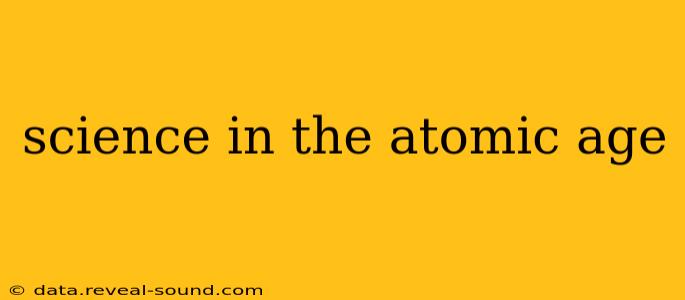The Atomic Age, ushered in by the mid-20th century's groundbreaking discoveries in nuclear physics, irrevocably altered the course of science and humanity. This era, marked by the harnessing of atomic energy and the subsequent development of nuclear weapons, presented unprecedented opportunities and challenges. This exploration delves into the scientific advancements, ethical dilemmas, and lasting legacies of this transformative period.
What were the major scientific discoveries of the Atomic Age?
The Atomic Age wasn't solely defined by the atomic bomb; it was a period of explosive scientific progress across various fields. The most significant discovery, of course, was nuclear fission—the process of splitting an atom's nucleus to release enormous energy. This understanding, coupled with advancements in particle physics and quantum mechanics, laid the foundation for nuclear power generation, medical isotopes (used in diagnosis and treatment), and various scientific instruments. Beyond nuclear physics, the post-war era saw rapid advancements in computing, space exploration, and biotechnology, all fueled, in part, by the momentum and funding generated by the Atomic Age's initial breakthroughs. This era saw the birth of powerful computers, paving the way for modern technology, and the Space Race, pushing the boundaries of our understanding of the universe.
How did the Atomic Age impact society?
The societal impact of the Atomic Age is profound and multifaceted. The most immediate and dramatic consequence was the development of nuclear weapons, forever altering warfare and international relations. The Cold War, a period of geopolitical tension characterized by an arms race, cast a long shadow over global politics and societal anxieties. On the other hand, nuclear energy offered a seemingly limitless source of power, promising solutions to energy crises. The development of medical isotopes revolutionized healthcare, providing crucial diagnostic tools and treatment options. However, the risks associated with nuclear technology, including radiation exposure and the potential for catastrophic accidents like Chernobyl and Fukushima, remain significant concerns. The public perception of science also shifted, with a growing awareness of both its potential benefits and inherent dangers.
What are the ethical implications of scientific advancements in the Atomic Age?
The ethical dilemmas raised by the Atomic Age are arguably its most enduring legacy. The creation of nuclear weapons forced a global conversation about the responsibility of scientists and the potential for scientific discoveries to be misused. The debate surrounding nuclear power plants highlights the tension between the need for energy and the risks of environmental contamination and potential accidents. The use of nuclear weapons in warfare raises fundamental questions about morality and the acceptable limits of destruction. These ethical questions continue to be debated today, influencing international policies and scientific research practices.
What is the legacy of the Atomic Age?
The Atomic Age left an indelible mark on the 20th and 21st centuries. Its legacy is a complex mix of technological advancements, geopolitical shifts, and ethical challenges. The advancements in nuclear medicine, computing, and space exploration represent monumental achievements, improving human lives and expanding our understanding of the universe. However, the threat of nuclear weapons and the potential for environmental catastrophes from nuclear technology serve as constant reminders of the responsibilities that accompany scientific progress. The Atomic Age compels us to reflect on the ethical implications of our scientific endeavors and the importance of responsible innovation.
How did the Atomic Age affect the scientific method?
The Atomic Age significantly accelerated scientific progress, not just in nuclear physics, but across various disciplines. The unprecedented funding poured into research during the Cold War spurred rapid advancements and fostered interdisciplinary collaboration. This era also saw the rise of large-scale scientific projects, requiring international collaboration and sophisticated management techniques. However, the secrecy surrounding certain aspects of nuclear research also raised concerns about transparency and the potential for the misuse of scientific knowledge. The need to manage the risks associated with nuclear technology further emphasized the importance of rigorous safety protocols and careful risk assessment within the scientific method.
What are some of the ongoing challenges related to the Atomic Age?
The challenges arising from the Atomic Age continue to this day. Nuclear waste disposal remains a significant environmental concern, requiring long-term solutions for safe storage. The proliferation of nuclear weapons poses a persistent threat to global security, necessitating international cooperation and arms control agreements. The potential for accidents in nuclear power plants, as evidenced by Chernobyl and Fukushima, highlights the need for robust safety measures and contingency planning. Addressing these challenges demands ongoing scientific research, international collaboration, and a renewed commitment to responsible innovation.
In conclusion, the Atomic Age stands as a pivotal period in human history, showcasing both the remarkable potential and the inherent risks associated with scientific progress. Understanding its impact is crucial to navigating the ethical and practical challenges posed by modern science and technology.
